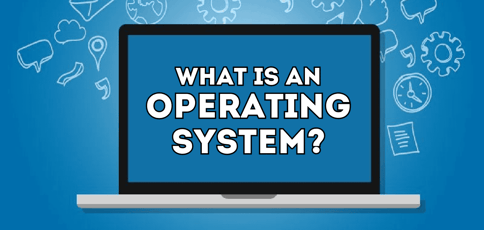
An operating system (OS) is like a computer’s brain. System software expertly allocates hardware resources (like memory and CPU time) among software applications and processes and acts as an interface between them.
It also starts, stops, and manages software and processes.
Other key functions of an operating system include memory optimization, access control and encryption, job accounting, file creation, manipulation and deletion, and device management — we’ll discuss these in detail soon.
The workings of the operating system are fascinating, so without further adieu, let’s explore everything you should know about an OS.
-
Navigate This Article:
Understanding Operating Systems
An operating system is similar to the human brain, which controls vital bodily functions through the brain stem — well, an OS has a “brain stem” called a kernel! To better understand operating systems, in this section, we’ll explore kernel fundamentals, operating system user interfaces (UIs), and the operating system utilities and services.
Kernel: The Brain Stem of an Operating System
The kernel is hands down the most important component of the OS, as it’s the bridge between computer hardware and applications.
It’s responsible for memory, task, and disk management, and system calls. While it seems like the kernel handles almost all of the system software’s tasks, it’s not to be confused with being the operating system — it’s merely a critical module.
There are three types of kernels:
- Monolithic kernel
- Microkernel
- Hybrid kernel
Monolithic kernels are popularly used by Unix and Linux operating systems and are considered to be the fastest. Microkernels are sparingly used but are reliable, robust, and offer excellent modularity and security.
Hybrid kernels are the most popular and are renowned for their high performance and flexibility — if you’re a Windows, macOS, Android, or iOS user, your OS uses a hybrid kernel.
OS User Interfaces (UIs)
There are two interactive OS user interfaces: the command line interface (CLI) and the graphical user interface (GUI).
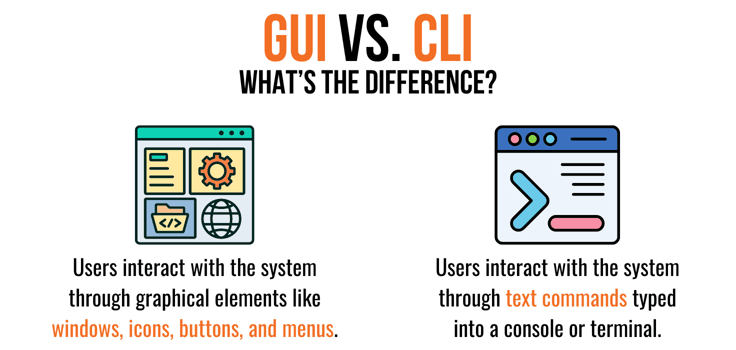
Pause for a second and look around your computer’s screen — the GUI is in action. It’s a visual interface with icons, menus, and windows that make it easy to browse the internet, watch videos, and play games.
The CLI allows you to interact with the operating system as well, but is text-based.
Simply put, you can perform the same actions using a CLI (for example, you could browse the internet using a terminal-based browser), but instead of clicking on visual elements, you’ll have to enter commands in a terminal or console window.
While a GUI is more pleasing to the eye and user-friendly, a CLI is faster, more efficient, consumes less memory and resources, and permits greater system control and customization.
System Utilities and Services
The operating system can’t do everything on its own — operating system utilities are software applications designed to complement the working of an OS by helping analyze, configure, and maintain a computer.
Popular utilities include the file manager program (which helps you manage and organize files), backup software (which is used for personal file backups), antivirus software (which helps prevent, detect, and remove malware), and disk cleanup tools (which help free up disk space).
Core Functions of Operating Systems
Operating systems are designed to make computer environments more “welcoming” and efficiently manage hardware and software resources — they’re easily the most important system software.
Operating systems’ five core functions are process management, memory management, file system management, device management, and security and access control.
Process Management
Any application running on your computer is termed a process (the web browser you’re currently on, for example).
Operating systems handle their creation and deletion, allocate processing power and other resources, schedule their execution, manage process communication and synchronization, and handle deadlocks.
Memory Management
Processes require memory to run, and the OS allocates it to them (from primary memory).
It decides which process will receive memory and at what time, keeps track of allocated memory (ensuring efficient use), deallocates memory when a process ends, and protects it from unauthorized access.
File System Management
Computer systems use numerous types of files, including executable files, source code files, textual data files, multimedia files, and markup files — efficient organization and secure access to them is a must.
This is where an operating system’s file system management capabilities come into the picture. Operating systems create, store, organize, manipulate, and control access to files and directories on storage devices like hard drives and solid-state drives.
Device Management
Currently, my laptop is connected to a printer and mouse. An operating system allows me to connect these devices (or any other physical or virtual device) with the system and access them.
Other device management capabilities include device driver management, device status monitoring, and device error handling.
When a device isn’t in use, the OS deallocates it — you can plug a pen drive or hard drive into your device and remove it to see this in action.
Security and Access Control
If you don’t have antivirus software or your firewall is turned off, your system may be compromised.
An operating system implements such technologies to protect your system from malicious attacks, unauthorized access, viruses, and worms.
Other security mechanisms include encryption, authorization, and authentication.
Don’t forget to create long, hard-to-guess passwords for each of your accounts. Never reuse or share your passwords with others.
Types of Operating Systems
Operating systems are like resource managers. There are numerous computer system variations, and they need different “resource managers” to handle basic tasks.
Each operating system type is designed to take care of contrasting tasks and scenarios. Here are some of the most sought-after operating system types.
Single-User vs. Multi-User Operating Systems
As the name suggests, a single-user operating system permits a single user to access the system at a given time. Mind you, this isn’t the OS used by Windows or Mac systems — a single-user OS can only run a single program at a time. Palm OS is a good example.
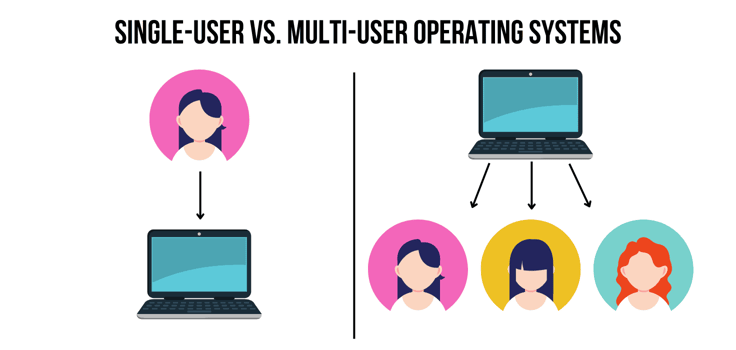
A multi-user operating system, on the other hand, allows multiple users to access the computer system at a given time.
They’re ideal for networked computing environments, promote resource sharing and collaboration, and allow users from remote locations to access the same system concurrently.
UNIX and Linux are quite easily the most popular multiple-user operating systems.
Single-Tasking vs. Multi-Tasking Operating Systems
A single-user operating system is a single-tasking system — as I explained earlier, such systems can only handle one task at a time and are inefficient and rather slow.
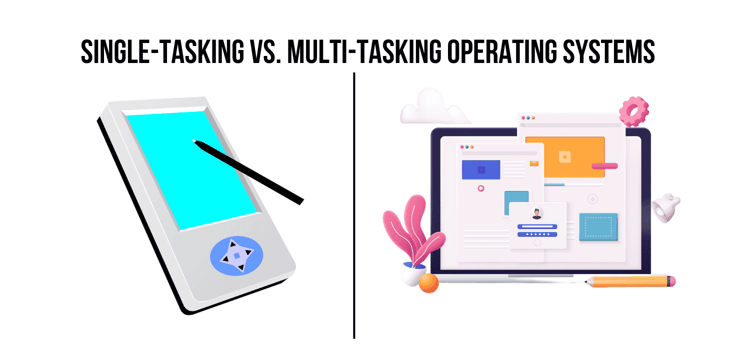
Older systems, like Palm handheld computers, used single-user operating systems.
Multi-tasking operating systems can allow a single user to run multiple tasks concurrently (Windows and macOS, for example) or multiple users to run multiple tasks simultaneously (UNIX and Linux, for example).
The key features of multi-tasking operating systems include time sharing, context switching, multi-threading, and hardware interrupts.
RTOS vs. General-Purpose Operating Systems
Real-time operating systems (RTOS) are used in real-time, time-constrained computer systems.
In such systems, tasks must be performed within a given time frame, or else the system will malfunction. While this sounds extreme, it’s crucial in control device applications like weapon systems, medical imaging systems, and automobile-engine fuel injection systems.
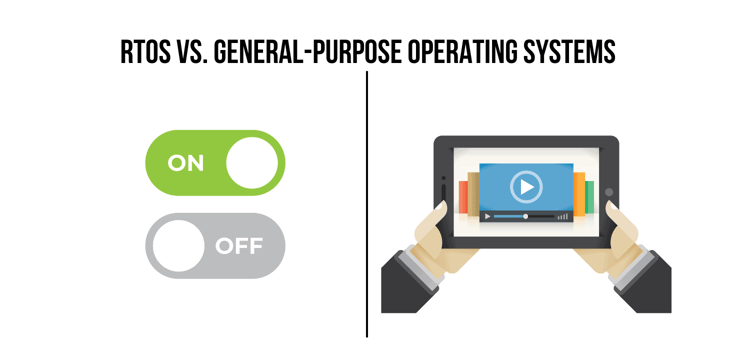
General-purpose operating systems aren’t time-constrained and perform non-critical tasks, like watching a movie on Netflix, playing the latest FIFA installment, or editing homework on Microsoft Word.
Scheduling isn’t necessarily prioritized in such systems (a fairness policy is employed). You guessed it right: Windows, macOS, UNIX, and Linux operating systems fall under this category.
Desktop Operating Systems: Windows, macOS, and Linux Distributions
We’re all familiar with desktop operating systems. They’re system software that manages the resources of a computer and liaises between hardware resources and software programs.
Windows, macOS, and Linux distributions fall under this category — each distribution has different hardware and software compatibility levels, performance attributes, and features.
While UNIX distributions can also be used for desktop applications, this is uncommon (UNIX is preferred for workstations and enterprise-level servers).
Mobile Operating Systems: iOS, Android, and Others
Last but not least, mobile operating systems power all handheld devices, like mobile phones (smartphones), tablets, and smartwatches.
I own an iPhone, which uses iOS software. Previously, I owned an Android phone (Samsung) that used Android software.
Mobile operating systems offer a touch-based GUI, allow multitasking, support numerous connection types, come with an app marketplace to download and manage applications, and efficiently allocate resources to enable battery optimization.
Evolution of Operating Systems
The first Windows operating system, Windows 1.01, was launched in November 1985, nearly four decades ago. The journey from Windows 1.01 to Windows 11 has been an intriguing watch (Windows 12 is around the corner).
Hundreds of operating systems (distributions) have been developed over the years, and the proprietary ones sure have advanced leaps and bounds: Microsoft Windows, Apple macOS, UNIX, and Linux.
Here’s a deep dive into the evolution of operating systems.
Historical Overview
The world’s first-ever functional general-purpose computer, the Analytical Engine, was conceptualized in 1837 by Charles Babbage (I bet you’ve heard about him!).
This system didn’t have an operating system, though. General Motors developed the first operating system in 1956, GM-NAA I/O, which can be considered the godfather of operating systems.
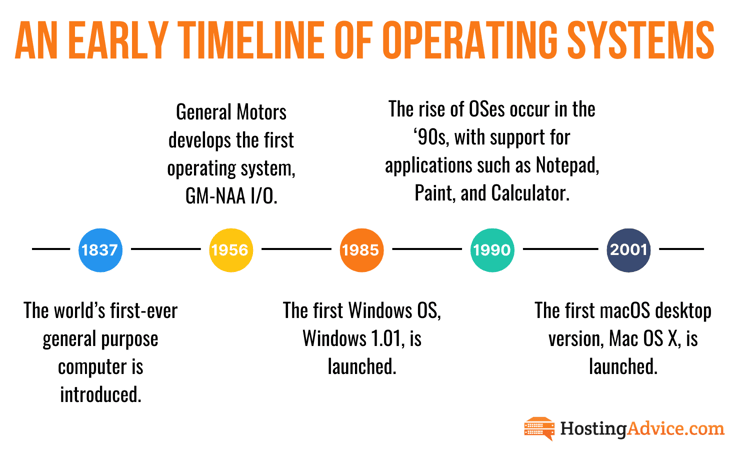
Microsoft Windows is undoubtedly the most popular desktop operating system provider, and its first retail release was Windows 1.01. If you belong to the 1990s or earlier, you’ve probably used computer systems that supported applications like Notepad, Paint, and Calculator.
Windows 1.01 introduced support for these gems! The first macOS desktop version, Mac OS X, was launched many years later in March 2001.
It featured a UNIX architecture and was codenamed “Cheetah.”
Major Milestones in the Development of Operating Systems
If you’re a computer geek (or just curious), you may want to explore major milestones in the development of operating systems — we’ve done the research for you. Here’s the in-between of the launch of GM-NAA I/O and Windows 11:
- GM-NAA I/O was developed by General Motors for the IBM 704 computer system in 1956.
- Advanced OS features like multitasking and memory processing were introduced with the Master Control Program (MCP) OS in 1961.
- Data General Nova computers, with their own operating systems, were launched in 1969. They were a perfect, low-cost solution for SMBs and laboratories.
- Microsoft Windows 1.01 was introduced in 1985, with a list price of $99 (a hefty fee, considering it was launched in the 1980s).
- Linus Torvalds released Linux, a UNIX-like OS kernel, in 1991 (he clearly named it after himself!).
- Windows 95 was launched to great fanfare in 1995.
- Apple released Mac OS X in 2001, marking the start of a great rivalry with Microsoft Windows. Starting with Windows XP, the Windows XP series was also born.
- Windows 11 was launched in 2021 and is the world’s second-most popular desktop OS (currently) after Windows 10.
If we were to talk about operating systems as a whole, Android is the most popular OS, followed by Windows. In terms of desktop operating systems, Windows commands 72.17% of the market share, followed by macOS (15.42%) and Linux (4.02%).
Trends and Advancements in OS Design and Architecture
GM-NAA I/O was advanced in the 1950s but could not perform multiple tasks simultaneously. The General Motors research division used it primarily for batch processing and grouping-related jobs.
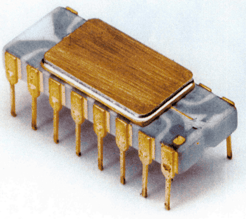
Operating system design and architecture began to flourish between 1965 and 1980 with the introduction of multi-tasking systems and minicomputers.
This era also introduced OS features like modular architectures, dynamic address translation, and personal, interactive systems. It’s worth noting that Intel introduced the first microprocessor in this period as well (in 1971). The rest is history, as they say.
Since the 1980s, we’ve seen tremendous growth in the space, from command line interfaces to GUIs, networked systems, mobile operating systems, and the beginning of Windows’ domination.
Today’s operating systems support advanced hardware integration and emphasize user convenience, adaptability to emerging technologies, and security.
Influence of Hardware Advancements and Computing Paradigms
As the bridge between computer hardware and processes, OS evolution has been heavily influenced by advancements in hardware and computing paradigms.
If we take a look at the IBM 704 computer, for example, it was limited by design and didn’t support multi-tasking — the GM-NAA I/O OS was only used for batch processing, I/O management, basic file management, and process planning.
As computer hardware and computing paradigms evolved, the roles and responsibilities of operating systems as a “resource manager” changed as well, requiring advanced OS architecture.
Kernel technology has advanced considerably over the years (it’s at the heart of operating systems). Windows NT was the first Windows OS to include a kernel (released in 1993); earlier releases used different OS architectures altogether.
Operating Systems in Practice
Operating systems aren’t just used in personal computers and smartphones — many machines that contain a specialized computing device use an operating system.
This includes smart TVs, video game consoles, smartwatches, voice assistants, web servers, smart fridges, and supercomputers. These machines run their own operating systems — let’s explore a few real-world applications in different industries.
Case Studies
Operating systems are used in just about every industry, from personal devices to gaming, manufacturing, healthcare, finance, and education.
The manufacturing industry, for example, has its own class of operating systems called manufacturing operating systems (MOSes). They’re responsible for managing each process of the production lifecycle.
Here are my three favorite operating system case studies.
Case Study 1: Operating Systems in Gaming
I’m big on gaming, so I couldn’t commence proceedings without exploring the use of operating systems in video game consoles.
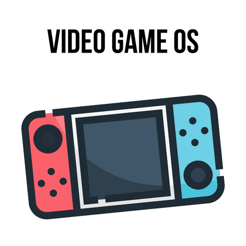
Consoles and personal computers are quite similar but don’t use the same operating systems. Game consoles use specialized operating systems (software kernels) that enable video game programmers to develop and optimize games for their respective platforms.
- Sony PlayStation 5 is powered by a custom OS based on open-source FreeBSD — this OS was designed by AMD and Sony.
- Nintendo Switch uses a hybrid operating system (firmware and OS) called Horizon, which is based on unique microkernel technology.
- Xbox One used a customized version of the Windows 10 operating system — this is no surprise, as the console allows you to run games, browse apps, and interact with other devices and services.
Modern game consoles are much more advanced than their predecessors. To put it into perspective, early counterparts either had similar operating systems or operated without one!
The integration of technologies like AR/VR, intelligent assistants, voice control, and IoT in operating systems will herald a new era for gaming — the future is bright!
Case Study 2: Operating Systems in Healthcare
Health is wealth, and the healthcare industry doesn’t muck around in its selection of operating systems.
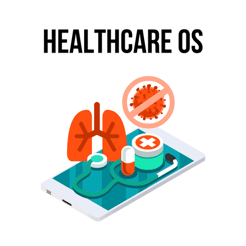
The industry uses a multitude of operating systems for personal computers and medical devices — Windows operating systems, real-time operating systems (RTOSs), and Linux operating systems find vast applications in healthcare.
- Windows operating systems are the most popular choice for desktop computers, and this applies to the healthcare industry as well. They’re easy to implement and use and are the standard choice for healthcare professionals.
- RTOSs are crucial to the day-to-day working of healthcare professionals, as they power real-time applications within medical devices (heart rate monitors and defibrillators rely on them, for example). Some of the most popular RTOSs for medical use include SAFE RTOS, Renesas, NXP, and ST Microelectronics.
- Linux is gaining momentum in healthcare as it combines the properties of RTOSs and GPOSs. It also provides a high level of security, making it a solid option for even the most complex medical devices.
One reason Linux isn’t the outright OS choice for medical devices is certification issues (it’s open-source, and you need to prove your device is safe for use) — the software you develop must meet IEC 62304 requirements.
Additionally, Linux isn’t exactly user-friendly for developers, and they may face a steep learning curve.
Case Study 3: Operating Systems in Smart TVs
No house is complete without a smart TV. I have a humongous Sony smart TV at home and am glued to it from nine to 11 PM.
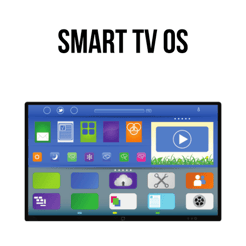
Numerous operating systems power smart TV technology, the most popular of which are Android TV (Google), WebOS (LG), and Tizen (Samsung)
- Life’s good if you have an LG smart TV. LG smart TVs use WebOS, which is renowned for being super fast and supporting multiple apps.
- Samsung’s Tizen is a fully stocked and rapid platform that supports a vast library of applications and services.
- The ultimate smart TV, Sony smart TVs, swear by Android TV technology. Several other smart TV companies also use the system software — any smart TV that brings Google Play Store to your screen uses it.
While it’s not my job to give you smart TV purchasing advice, you can’t go wrong with a Sony smart TV (Samsung is another solid option), especially due to its sound OS.
Android TV software is user-friendly, integrates thousands of applications and games from Google Play Store, and is silky smooth. Other brands that use the system software include Toshiba, Kodak, and Realme.
Common Use Cases
GPOSs like Windows, macOS, Linux, Android, and iOS are mostly used on personal computers, smartphones, and tablets, and they are by far the leading operating systems.
Linux is also used in embedded systems (like routers and switches), application servers, and large cloud structure environments.
UNIX operating systems serve as the backbone of the internet and are used in embedded systems, server applications, and high-performance computing.
RTOSs find common applications in fields like healthcare (as we explored in detail), industrial control, flight simulation, weapon systems, telephone switching equipment, and real-time simulations.
While single-tasking operating systems aren’t commonly used, they are used in legacy environments, two-way messaging devices, wireless phones, and other specialized devices.
Best Practices
If you own a Macbook or Windows (like Dell or HP) desktop, choosing an operating system is easy — simply purchase and install the latest version of macOS or Windows, respectively!
On a more serious note, the first step is to analyze your needs. If you need an OS for personal use, for example, depending on your system’s configurations, you’re limited to Windows, macOS, Linux, Android, and iOS operating systems.
UNIX (and Linux for particular use cases) operating systems are best suited to server applications, robust development and programming, automation and scripting, networking and communication, and data security.
Real-time applications, like medical devices, require specialized operating systems (RTOSs), such as SAFE RTOS and ST Microelectronics.
Ensure your operating system performs the exact functions you need, keep your system up to date, and look up the best practices of your respective operating system to stay on top of things — the following section should shed some more light.
Challenges and Considerations
There are a few key challenges and considerations in operating system administration and maintenance, both in the personal and organizational context:
- Account management is an important consideration. Ensure your account is password-protected and has proper authentication and access control mechanisms.
- Ensure all software is compatible with your operating system and up to date.
- Properly configure system settings, network parameters, and security policies and regularly review and update them.
- Backup and disaster recovery methods must be in place as well.
- Establishing media controls, maintaining an accurate log of everything related to your system, and performing regular system maintenance are also crucial.
If you follow all these steps, the integrity and availability of your chosen operating system should be intact. Always adhere to best practices and treat your system like a plant that needs constant nurturing.
Future Trends in Operating Systems
We’ve already moved into a more customer-centric reality; “Customer is king” has never been truer.
The goal is to deliver streamlined, personalized, and secure customer experiences — operating systems are no strangers to this trend.
Read on to learn about some of the emerging technologies that are set to shape the future of operating systems and what their future landscape may look like.
Emerging Technologies
Internet of Things (IoT), cloud computing, and edge computing are set to be at the heart of new-look operating systems.
Let’s take the example of IoT devices in a home environment, like smart home appliances (including smart fridges, ovens, dishwashers, and vacuums) and wearables. Shortly, users will be able to control and monitor such devices from a single operating system interface.
In terms of edge computing, operating systems will seamlessly integrate and orchestrate resources across distributed environments. This will enable applications to be quicker and more responsive.
The coolest application of all, though, may be the ability to download your OS applications and environment settings from the cloud and access them from any computer you’re logged in to!
Artificial Intelligence and Machine Learning
Integrating artificial intelligence (AI) and machine learning (ML) in OS design will make our lives easier.
For example, to open a web browser on your computer device and play a preferred video on YouTube, you have to click a few buttons and type some words.
Through technologies like natural language processing (NLP) and AI, you can perform these tasks without lifting a finger.
Imagine being able to “narrate” an email — how easy would that make your life!
Security and Privacy
Security enhancements and privacy features in next-generation operating systems will include improved authentication methods, secure boot processes, and advanced encryption.
Additionally, users will have greater control over data and enjoy privacy-enhancing features like transparent data handling, data tracking controls, and advanced permissions for applications and services.
The Future Landscape
The future landscape of operating systems and computing environments promises much, as is evident from the above sections.
Let’s take the example of the upcoming release of Windows 12 to better understand the near future of operating systems.
AI-based synergies (with Copilot at the center of development), a modular system design with multi-device linking (smartphones and tablets), native file compressing and decompressing, and energy efficiency are some important themes that will likely be explored.
Navigating the Future Landscape of Operating Systems
Operating systems have a foundational role in computing; It’s nearly impossible to sanely operate a computer system without one.
Now, if you’re a coding maestro and have ample time to spare, you could create a functional program using machine code to perform the role of an operating system… or you could just purchase an operating system license like Windows 11 or macOS 13.0 Ventura.
Operating systems have been around since the 1950s and make it possible to extract maximum value from a computer system. They’re more than just resource managers — they’re like the conductor of a beautiful orchestra (that is your computer).
Exciting innovations and transformations await us in the operating system space, so fasten your seatbelts and enjoy the ride; Windows 12 may just be a game changer.







